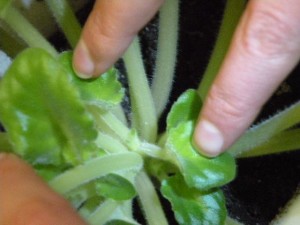Propagating Parma Violets

Many of us know that Parama violets multiply by the leaf. From a leaf we can get a chicken, doi, six or even more. Let this be the only way to multiply these tender flowers?
In the following, I will present some ways of multiplying African Violets.
First version: Breeding in water.
A fairly simple option and probably very often practiced. A healthy leaf is chosen, it is desirable to be from row 2 or 3 of the crown. We make an oblique cut, with a blade or a thin-bladed knife, on the stem of the leaf. It is desirable that the length of the stem after making the cut should be 3-5 cm. The leaf is placed in water in a plastic bottle, or a disposable cup, or in any other small dark colored vessel. The water must be at room temperature and not be changed during the entire breeding period. Instead, we must be careful when its level drops. And to be sure that the stem does not rot, add a small piece of charcoal or a few grains of potassium permanganate to the water. The bottle is placed on a wooden or plastic support, away from a strong source of heat or light. Fulfilling these conditions, in 2-3 weeks the first roots will appear.
When the roots reach the length of 0,5 – 1 cm, the leaf can be planted in loose soil, light and sandy. It is planted obliquely and at a depth of 0.5- 1.5 cm, for this reason it is necessary to put a proptea under the leaf until it gains strength. After a month and a half or even two we can enjoy the appearance of the first puppies.
If the cut turns black and starts to rot, we make another cut removing the diseased stem.
The second variant: Propagation of African violets directly in the ground.
 It's a safer option, the cubs are more vigorous, instead, their appearance lasts.
It's a safer option, the cubs are more vigorous, instead, their appearance lasts.
In case we opt for this method of multiplication, the stem of the leaf must be no longer than 2-3 cm. The obliquely cut leaf is planted in the ground at a depth of 0.5- 1.5 cm. The soil must be loose and light. Peat can also be included in its composition, But with a condition, the pH value should be as low as possible. The soil must be kept moist, until the chicks appear.
The waiting time is a bit longer, two or even three months. When the chicks reach a length of 4-5 cm, they can be planted separately. First in disposable cups, and as it grows, they are planted in larger pots.
Option 3: Reproduction through chickens.

As a rule, these babies appear on the stem of the mother plant. Even if we don't want to plant them, it is necessary to clean the stem of the violet from these chicks. regularly, the chicks stop the flowering of the mature plant and weed it.
It's a very simple option that doesn't involve too much waiting time. The shoots of a length of 3-4 cm are cut accurately from the stem of the mother plant. They are put in the water, in a small bowl. The water level must not exceed the core; the plant. Roots usually appear after 2-3 weeks. They are planted in the ground when the length of the roots is 0.5-1 cm. Cut seedlings can also be planted directly in the ground.
Variant 4. Rejuvenating the old plant.
 What do we do when our violet has bloomed 3-4 times and suffered leaf loss? We have in front of us a plant that looks like a palm tree. A thick and long stem with a few leafless leaves at the top. Let's throw it away? Is this the way out of the situation??
What do we do when our violet has bloomed 3-4 times and suffered leaf loss? We have in front of us a plant that looks like a palm tree. A thick and long stem with a few leafless leaves at the top. Let's throw it away? Is this the way out of the situation??
Well, we can successfully bring the flower back to its former appearance.
With a knife with a thin blade, cut the stem of the violet 1cm below the top of the plant. We carefully clean the piece of stem from the dark colored rice and repeat the procedure described in the 1st multiplication option.
Careful! The cut must not touch the bottom of the glass.
2-3 weeks passed and we woke up with the first roots. When they have reached the length of 1cm, the plant is planted in the ground.





Hello, I'm glad I found your site, you are a very good housewife,give recipes for sweets, crochet,you knit and you like violets, you have them so beautiful that I will start growing violets, now I have only 2 pots with blue violets. I read about their cultivation it is very interesting. Good evening.
To this, Adina!
Violets are an older passion. I take care of them with pleasure, because they always give me peace and soul balance. And they feel me too, always make me happy with flowers in abundance.